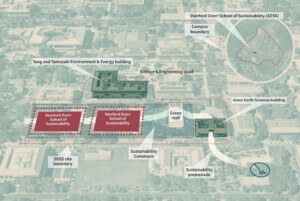Stanford students have taken on an interesting new challenge: creating an edifice that disappears. A just-completed studio, “Transparent Structures,” taught by architect Beverly Choe and structural engineer Jun Sato, investigated glass as a structural system using engineered, high-strength glazing. Thanks to a donation from Asahi Glass, students got to build a pavilion using chemically treated glass usually made for smartphones. (Similar to Guerrilla Glass, the best-known smartphone cover.)
The pavilion’s roughly 100 square panels were held together by aluminum straps and rubber hose gaskets, their transparency subtly changing with different types of film. The vaulted passage, located on the school’s Science and Engineering Quad, was lit by LED lights powered by a car battery. Choe’s goal, besides creating the glass palace, was to “create a class that was very collaborative.” She succeeded, drawing together students from the school’s architecture, engineering, and product design departments.
Each specialty’s strength came out in the process, with structural engineers taking the lead on prototyping, architects taking the lead in conceptual design, and so on. “The product was quite different than if we had just had architecture students,” said Choe.








